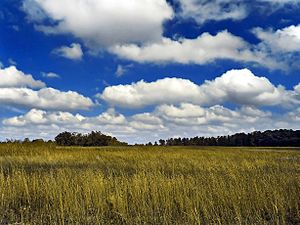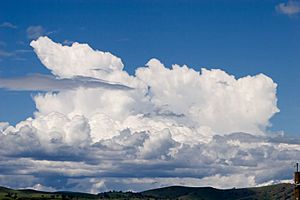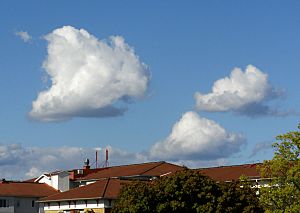Cumulus cloud facts for kids
Quick facts for kids Cumulus |
|
|---|---|

Small cumulus humilis clouds that can have noticeable vertical development and clearly defined edges.
|
|
| Abbreviation | Cu |
| Symbol | |
| Genus | Cumulus (heap) |
| Species |
|
| Variety |
|
| Altitude | 200–2,000 m (1,000–7,000 ft) |
| Classification | Family C (Low-level) |
| Appearance | Low-altitude, fluffy heaps of clouds with cotton-like appearance. |
| Precipitation | Uncommon Rain, Snow or Snow pellets |
Cumulus clouds are fluffy, cotton-like clouds. They have flat bottoms and puffy tops. People often say they look like cauliflower! You can usually see their flat bases, but their tops are always changing shape. Their name comes from a Latin word, cumulo-, which means 'heap' or 'pile'.
These clouds are usually low in the sky. They are often less than 2,000 m (6,600 ft) (about 7,000 feet) high. However, some types, like cumulus congestus, can grow much taller. You might see cumulus clouds alone, in lines, or in groups.
When you see cumulus clouds, it means the air is mixing well. This happens because air is moving up and down. If a cumulus cloud grows very large, it can turn into a cumulonimbus cloud. This is a type of thunderstorm cloud. This means the air is rising very high, sometimes even to the stratosphere.
Cumulus clouds can be made of water vapor, tiny supercooled water droplets, or even ice crystals. What they are made of depends on how cold the air is around them.
Contents
How Do Cumulus Clouds Form?
Cumulus clouds form when air near the ground gets warm and starts to rise. As this warm air goes higher, it gets cooler. This cooling causes the air's relative humidity to go up. When the air cools enough, the water vapor in it turns into tiny water droplets. These droplets then stick to tiny particles in the air, forming the cloud.
These clouds can be made of ice crystals, water droplets, or a mix of both. The water droplets form when water vapor condenses. They can then join together to make bigger droplets.
How tall a cumulus cloud gets depends on the air's temperature. It also depends on if there are any temperature inversions. An inversion is like a lid in the sky that stops air from rising higher.
Sometimes, cumulus clouds can have "holes" in them. These holes happen when strong winds tear the cloud apart. They can also form when air moving downwards makes the water droplets disappear.
What Do Cumulus Clouds Tell Us About the Weather?
Small cumulus clouds, called Cumulus humilis, usually mean the weather will be nice. They are a sign of fair weather.
Cumulus mediocris clouds are a bit taller. They show that the air is rising more. This means they could grow into cumulus congestus clouds. These taller clouds can even become cumulonimbus clouds. Cumulonimbus clouds can bring heavy rain, lightning, strong winds, hail, and even tornadoes.
Cumulus congestus clouds look like tall towers. They often grow into cumulonimbus storm clouds. These clouds can produce rain. People who fly gliders watch cumulus clouds closely. This is because cumulus clouds can show where rising air currents, called thermals, are. These thermals can lift a glider high into the sky. This is sometimes called "cloud suck."
Cumulus Clouds on Other Planets
Clouds similar to cumulus clouds have been found on most other planets in our solar system.
- On Mars, the Viking Orbiter saw cirrocumulus and stratocumulus clouds. These clouds formed near the planet's ice caps.
- The Galileo space probe found huge cumulonimbus clouds on Jupiter. They were near the planet's Great Red Spot.
- Cumulus-like clouds have also been seen on Saturn. In 2008, the Cassini spacecraft found cumulus clouds near Saturn's south pole. These clouds were part of a giant cyclone, over 4,000 kilometres (2,500 mi) wide.
- The W. M. Keck Observatory saw whitish cumulus clouds on Uranus.
- Like Uranus, Neptune has cumulus clouds made of methane.
- However, Venus does not seem to have cumulus clouds.
See also
 In Spanish: Cúmulus para niños
In Spanish: Cúmulus para niños



